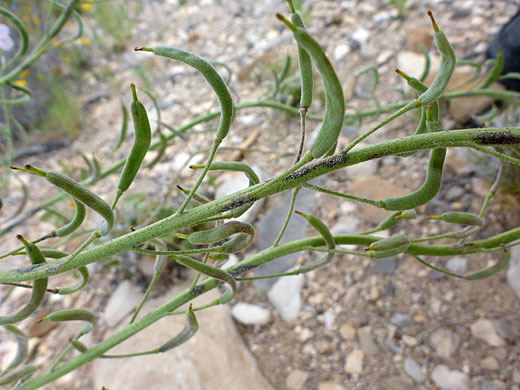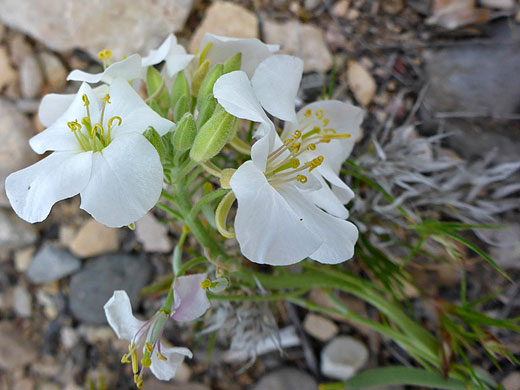Nerisyrenia Camporum, Bicolored Fan-Mustard
Plants > Wildflowers > Brassicaceae > Nerisyrenia Camporum

White flowers and green buds - nerisyrenia camporum along the Dome Trail, Big Bend Ranch State Park, Texas
Common name:
Bicolored fan-mustard
Family:
Scientific name:
Nerisyrenia camporum
Main flower color:
Range:
New Mexico, west/south Texas and a small area of Arizona
Height:
Up to 2 feet
Habitat:
Washes, gravelly areas, hillsides, clay flats
Leaves:
Obovate to oblanceolate; up to 1.5 inches long and 1 inch across
Season:
February to September
Stems and leaves of nerisyrenia camporum have an even covering of soft white hairs, though with age, the lower part of the stem becomes hairless, and woody. Lower stem leaves taper at the base to a short stalk; upper stem leaves are sessile. Leaf margins can be smooth, wavy or coarsely toothed, while the tips may be rounded or pointed.
Plants can bloom any time of year, but do so mostly in spring and summer. Flowers form as an elongated cluster along the upper portion of the stem. The four green sepals are oblong in shape, and lightly hairy, while the four larger white to pale pink petals are obovate, and clawed; narrower at the base. The six anthers are yellow, on top of green stamens, while the style and stigma are greenish. Petals turn pink as they wither. Fruits are broad, green, flattened cylinders, usually curved lengthways, generally ascending.
Plants can bloom any time of year, but do so mostly in spring and summer. Flowers form as an elongated cluster along the upper portion of the stem. The four green sepals are oblong in shape, and lightly hairy, while the four larger white to pale pink petals are obovate, and clawed; narrower at the base. The six anthers are yellow, on top of green stamens, while the style and stigma are greenish. Petals turn pink as they wither. Fruits are broad, green, flattened cylinders, usually curved lengthways, generally ascending.
All Contents © Copyright The American Southwest | Comments and Questions | Contribute | Site Map








